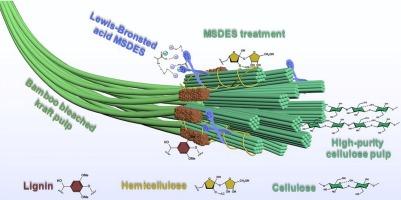双官能团酸场所处理的深共晶溶剂将竹牛皮浆升级为纤维素-醋酸盐级溶解浆
IF 10.7
1区 化学
Q1 CHEMISTRY, APPLIED
引用次数: 0
摘要
在中国,将非木浆(如竹漂牛皮浆)转化为高纯度醋酸纤维素(CA)级溶解浆至关重要,但具有挑战性。为此,本文比较研究了一系列基于金属盐的深共晶溶剂(MSDESs),包括各种氯化锌-脲(U)、氯化锌-甘油(G)和氯化锌-乳酸(LA)。ZnCl2-LA MSDES 具有路易斯酸 ZnCl2 和布氏酸 LA 的双功能酸位点,因此酸度(2.62)最高,与竹纤维的相互作用亲和力也最强,从而在同时净化和活化纸浆方面效率最高。因此,由 ZnCl2-LA 制成的升级纸浆(DES3-F)在纯度(从 80.8% 提高到 93.1%)、固有粘度(从 897 毫克/升提高到 419 毫克/升)和反应性(从 18.1% 提高到 80.8%)方面都有显著提高。此外,改性醋酸盐产品的取代度高达 2.84,产率为 75.5%。简而言之,这种拟议的 MSDES 处理方法可为生产高质量溶解浆及其衍生物提供一种前景广阔的替代方法。本文章由计算机程序翻译,如有差异,请以英文原文为准。

A deep eutectic solvent with bifunctional acid sites treatment to upgrade a bamboo kraft pulp into a cellulose-acetate grade dissolving pulp
Valorization of non-wood pulp, such as bamboo bleached kraft pulp into high-purity cellulose acetate (CA)-grade dissolving pulp is crucial but challenging in China. Herein, a series of metal salt-based deep eutectic solvents (MSDESs) involving various ZnCl2-urea (U), ZnCl2-glycerol (G), and ZnCl2-lactic acid (LA) are comparatively investigated for this purpose. Thanks to the bifunctional acid sites of Lewis acid ZnCl2 and Brønsted acid LA, the ZnCl2-LA MSDES has the highest acidity (2.62) and interaction affinity to bamboo fibers, leading to the highest efficiency in simultaneous pulp purification and activation. As a result, the resultant upgraded pulp from ZnCl2-LA (DES3-F) features remarkable improvements in purity (from 80.8 % to 93.1 %), intrinsic viscosity (from 897 to 419 mg/L), and reactivity (from 18.1 % to 80.8 %). Moreover, the modified acetate product has a high degree of substitution of 2.84 and a yield of 75.5 %. In short, such a proposed MSDES treatment can offer a promising and alternative approach for the manufacture of high-quality dissolving pulp and its derivatives.
求助全文
通过发布文献求助,成功后即可免费获取论文全文。
去求助
来源期刊

Carbohydrate Polymers
化学-高分子科学
CiteScore
22.40
自引率
8.00%
发文量
1286
审稿时长
47 days
期刊介绍:
Carbohydrate Polymers stands as a prominent journal in the glycoscience field, dedicated to exploring and harnessing the potential of polysaccharides with applications spanning bioenergy, bioplastics, biomaterials, biorefining, chemistry, drug delivery, food, health, nanotechnology, packaging, paper, pharmaceuticals, medicine, oil recovery, textiles, tissue engineering, wood, and various aspects of glycoscience.
The journal emphasizes the central role of well-characterized carbohydrate polymers, highlighting their significance as the primary focus rather than a peripheral topic. Each paper must prominently feature at least one named carbohydrate polymer, evident in both citation and title, with a commitment to innovative research that advances scientific knowledge.
 求助内容:
求助内容: 应助结果提醒方式:
应助结果提醒方式:


